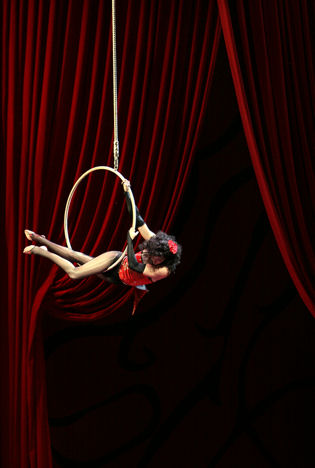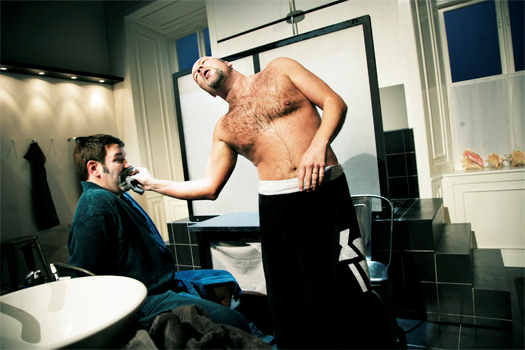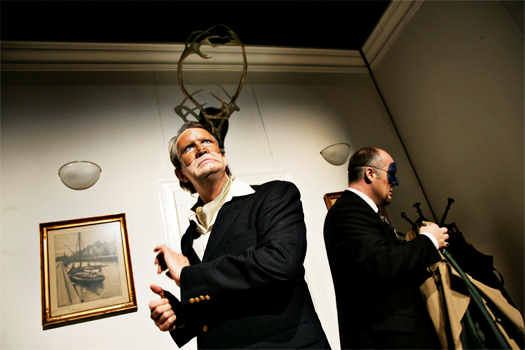Other Links
Editorial Board
- Editor - Bill Kenny
- London Editor-Melanie Eskenazi
- Founder - Len Mullenger
Google Site Search
SEEN
AND HEARD INTERNATIONAL OPERA REVIEW
Nielsen,
Maskarade :
at the Royal Danish Opera,
Copenhagen,
26.1.2008 (GF)
When Bill Kenny visited
For the first time in the history the Royal Danish Opera have
staged Maskarade in a modernized version. Kasper Bech
Holten and Morgan Alling have transported it from the time of
Holberg to the present day and Holten defends this venture in an
essay in the programme book, and his thesis is that even though
there is a lot that speaks for sticking to tradition, this could
also be seen as a lack of respect for the work, that we don’t
believe that it has substance enough to be revived in a new shape.
Maskarade is about being Danish and this Danishness is not
only nostalgia, we have to interpret it into the present day. This
reading of Maskarade is about how the Danish hide behind
masks, not at the masquerade but in real life, and it is also
about dreams, about letting free the dreams, the passion and the
longing. It is a daring reading and there is always a risk that
the whole production will fall flat to the ground. But it doesn’t!
This production is literally floating above the ground and, most
important of all, the direction never goes against the
music, as too many modern productions tend to do, but it lives and
works in symbiosis with the music, and I can’t give higher
praise than this to a production, since the music is after all the
kernel of every opera.
This was a performance filled with humour, life and human feelings
exposed and there was hardly a moment where there wasn’t something
amusing or thrilling or inventive happening – often simultaneously
in the background or in an adjacent room as a kind of
counterpoint. One shouldn’t reveal too much but when it is time to
sleep in act 2 the Sandman arrives in white nightshirt and on
inlines! In
Directed by Kasper Bech Holten and Morgan Alling
Sets and Costumes: Marie í Dali
Lighting Design: Jesper Kongshaug
Cast:
Jeronimus – Christian Christiansen
Magdelone – Susanne Resmark
Leander – Niels Jørgen Riis
Henrik – Johan Reuter
Arv –
Ole Hedegaard
Leonard – Poul Elming
Leonora – Anna Rydberg
Pernille – Djina Mai-Mai
and
others
The Royal Opera Chorus, Sjaelland Symphony Orchestra/Frans
Rasmussen

Maskarade,
with a libretto by Vilhelm Andersen, based on Ludvig Holberg’s
comedy Mascarade from 1724, was premiered on 11 November
1906 and is regarded as the Danish national opera. This
performance was the 284th at the Royal Danish Opera,
which means that it is one of the most popular operas on the
repertoire in Copenhagen during the last one hundred years.
Internationally it is less well known than Nielsen’s central
orchestral output: the six symphonies, the concertos and a few
other works, but during the last decades it has appeared now and
then outside Denmark and last year Covent Garden staged it for the
first time. I had seen it only once before and that was in
Stockholm almost 30 years ago with a splendid cast including the
young Gösta Winbergh, Loa Falkman, Arne Tyrén, Barbro Ericson and
internationally renowned Wagner tenor Helge Brilioth. It was a
fine performance but of course there is something special to see
and hear an opera performed in the original language by a cast of
– mainly – native speakers. The score is filled with some of the
most inspired music Carl Nielsen ever wrote: lively, humoristic,
colourful on the one hand; lyrically beautiful with folksong like
melodies, closely related to Nielsen’s masterly songs for voice
and piano, on the other. The libretto may be less of a masterpiece
and the story is fairly predictable, but this is of course
something this work has in common with many other operatic
comedies – and also a fair amount of boisterous, sometimes even
chaotic action that not every opera lover adores. My wife is one
of them. She admits the musical qualities and in the last resort
she was reluctantly impressed by the staging and the direction at
large but would willingly have forsaken some of the “business”. To
a certain extent I can agree but for the most part I love this
opera, which I have known for a long time through John Frandsen’s
Unicorn recording.

The state-of-the-art stage machinery allows for advanced technical
solutions and the first act played in a number of adjacent rooms,
lying in file, and when the action moved from one room to the next
the file of rooms moved accordingly, so that the action was always
centre stage. At the end of the act the action was reversed and it
ended as it started: in Leander and Henrik’s bedroom, seen from a
bird’s eye view. The second act was more static with a row of beds
against a house front with lots of windows, while the third and
final act was in a large theatre with acrobats and crowds of
people, one of the acrobats arriving on a wire from somewhere
above and behind the audience like The Phantom of the Opera. The
whole act was great entertainment and the crowd on stage even
invited the audience to join in clapping hands. At the end the
ensemble invaded the stalls and surrounded the audience there.

For a production like this, requiring exact timing and expressive
body language, a cast of excellent singing-actors is essential –
and that is what the Royal Opera can provide. Singing in one’s
mother-tongue certainly facilitates the acting and there wasn’t a
weak member in this cast. Christian Christiansen’s rowdy Jeronimus
roared, shouted, growled and occasionally sang his way through his
role – a kind of distant relative of Falstaff’s. His wife,
Magdelone, was impressively sung and acted by Susanne Resmark, who
is equipped with a mezzo-soprano voice with beauty as well as
power. Poul Elming, in the 1990s
Bayreuth’s
Siegmund, turned out to be a comedian of stature and in one of the
dream sequences in the last act he also showed his skill at
chewing and blowing bubblegum.
The tenor lead Leander is the one who has the most beautiful music
to sing and Niels Jørgen Riis had a fine lyrical voice, slightly
reedy but with a fine ring, not least in the magical love
duet in the second act. Johan Reuter’s steady and powerful
baritone seemed ideal for Henrik and he was also a superb actor.
Leonora and Pernille were well performed by Anna Rydberg and Djina
Mai-Mai and Ole Hedegaard should be mentioned for his hilarious
portrait of the Polish guest worker Arv. The acrobats in the third
act offered circus entertainment of the highest order and Geneviève Gauthier’s trapeze numbers were
especially outstanding.
Veteran conductor Frans Rasmussen lead the Sjaelland Symphony
Orchestra in a scintillating performance of Nielsen’s vital score,
where the spirited overture set the seal on the whole evening and
the opera chorus were excellent.
This was a life-enhancing evening and, lo and behold, when we left
the opera house the rain had stopped and the wind had started to
die away. The power of music?
Göran
Forsling
Photos © Per
Morten Abrahamsen
